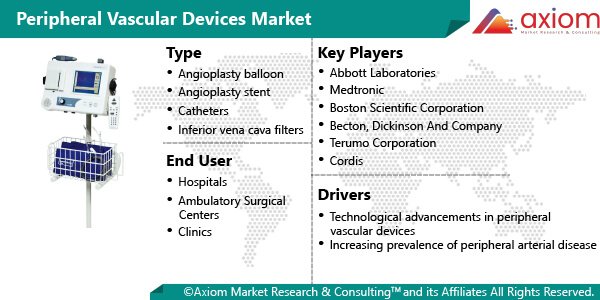Peripheral vascular disease alludes to any disease or disorder of the circulatory system outside of the brain and heart. The term can include any disorder that affects any blood vessels. When vessels don’t supply adequate blood, it results in the irregular functioning of organs. PVD is the most common disease of the arteries. Approximately 10% of the world’s population have PVD. Most of the people with PAD are asymptomatic., however, have limited walking ability and therefore reduced quality of life. The various devices used to treat Peripheral vascular disease include Percutaneous Transluminal Angioplasty (PTA) balloons, peripheral vascular stents, PTA Drug-Eluting Balloons (DEBs), embolic protection devices, aortic stent grafts, Inferior Vena Cava Filters (IVCFs), synthetic surgical grafts and peripheral guide wires.
Peripheral Vascular Devices Outlook
Growth of the global peripheral vascular devices market is driven by the rapid growth in the geriatric population and the subsequent increase in the prevalence of peripheral vascular diseases. As indicated by United Nation estimate the global population aged 60 years was recorded to 962 million in 2017and is expected to double by 2050, to reach nearly 2.1 billion. Geriatric populace is prone to different chronic illnesses attributable to structural changes in the ageing population, which will increase the demand for Peripheral Vascular Devices. With the aging of worldwide populace, it appears to be likely that Peripheral Vascular Disease will be progressively in future. Consequently, the insights demonstrate that the number of PAD is expanding at a quicker pace, which is eventually driving the market of Peripheral Vascular Devices. Further increasing prevalence of diabetes, growing demand for minimally-invasive procedures, especially for peripheral arterial disease, lifestyle changes, and technological advancements have extended the range of peripheral vascular devices.
Peripheral Vascular Devices Market Segmental Overview
The report analyses the global Peripheral Vascular Devices based on product type, end user and geography.
Peripheral Vascular Devices Market by Product Type
Peripheral vascular device market is segmented based on its types as Angioplasty Balloon ( which includes Old/Normal Balloons, Cutting and Scoring Balloons and Drug-Eluting Balloons), Catheters (which consist of Angiography Catheters, Guiding Catheters, IVUS/OCT Catheter), Endovascular Aneurysm Repair Stent Grafts (which incorporates Abdominal Aortic Aneurysm Stent Grafts and Thoracic Aortic Aneurysm Stent Grafts), Inferior Vena Cava Filters ( which is sub segmented into Retrievable Filters and Permanent Filters), Plaque Modification Devices ( which incorporates Atherectomy Devices and Thrombectomy Devices), Hemodynamic Flow Alteration Devices ( which includes Embolic Protection Devices and Chronic Total Occlusion (CTO) Devices) and Other Peripheral Vascular Devices (Guidewires, Vascular Closure Devices, Introducer Sheaths and Balloon Inflation Devices) and Angioplasty Stents (consisting of Drug-Eluting Stents and Bare-Metal Stents). Further, Bare-Metal Stents segment is sub categorised into Balloon-Expandable Stents and Self-Expandable Stents.
Angioplasty catheter is a medical device which is inserted into the artery to clear the blockage and allow the clogged blood to flow. The global Angioplasty catheter market is expected to grow at a lucrative CAGR over the forecast period. Th increasing application of angioplasty catheter coupled with the technological advancements, and introduction of innovative products are some of the major factors driving the growth of the PTCA balloon catheter market.
Peripheral Vascular Devices Market by End User
On the basis of end user, the global Peripheral Vascular Devices has been segmented into Hospitals, Ambulatory Surgery Centers, Specialty Clinics others. Hospitals segment held the significant market share and anticipated to robust growth during the forecast period owing to the increase in the number of surgeries being performed at hospitals coupled with the availability of advanced healthcare facilities and increasing affordability of treatment due to the rising disposable income.
Peripheral Vascular Devices Market by Geography
On the basis of region, the peripheral vascular devices market is segmented into North America, Europe, Asia Pacific, and the Rest of the World (RoW).
North America has dominated the peripheral vascular devices market in 2018. The dominance of North America is attributed to the factors such as such as, increasing incidence of peripheral vascular diseases, growing geriatric population, presence of sophisticated healthcare infrastructure, healthcare expenditure and high R&D pertaining to drug discovery and development and the strong presence of industry players in the region. Europe holds the second largest position in the market, which is being followed by the APAC region. However, Asia Pacific is expected to be the most lucrative regional market during the forecast period on account of world’s largest population present in this region with a noticeable number of people suffering from heart diseases, increasing focus of major players on this region, growing healthcare expenditure and positive government support.
Peripheral Vascular Devices Market Key Players
The major players operating in the peripheral vascular devices market includes Medtronic (Ireland), Boston Scientific Corporation, Abbott, Cardinal Health, iVascular, Becton, Dickinson and Company , B. Braun Melsungen, Bayer Healthcare, Terumo Corporation, Biosensors International Group , and BIOTRONIK SE & Co. KG among others. The manufacturers are adopting key development strategies to create next generation devices. Large numbers of clinical trials are in progress to increase the safety and efficacy of devices.
Recent Developments:
September, 2018 : Boston Scientific received the U.S. Food and Drug Administration (FDA) for Premarket Approval (PMA) application to market the Eluvia Drug-Eluting Vascular Stent System, specifically developed for the treatment of peripheral artery disease (PAD).
September, 2018 : Boston Scientific received the U.S. FDA approval for Eluvia Drug-Eluting Vascular Stent System,, developed for the treatment of peripheral artery disease (PAD)
November, 2018 : Medtronic plc received CE Mark approval for the Valiant Navion(TM) thoracic stent graft system followed by the recent U.S. FDA approval of the Valiant Navion system.
December, 2017: Becton, Dickinson and Company, a global medical technology company, completed the acquisition of C. R. Bard, Inc., the combined company is uniquely positioned to improve both the treatment of disease for patients and the process of care for health care providers.











